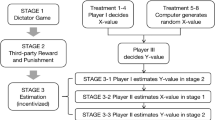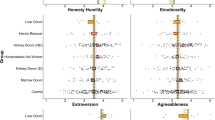Abstract
Arising from: E. Fehr & S. Gächter Nature 415, 137–140 (2002); E. Fehr & S. Gächter reply Altruistic punishment is a behaviour in which individuals punish others at a cost to themselves in order to provide a public good. Fehr and Gächter1 present experimental evidence in humans indicating that negative emotions towards non-cooperators motivate punishment, which, in turn, provokes a high degree of cooperation. Using Fehr and Gächter's original data, we provide an alternative analysis of their experiment that suggests that egalitarian motives are more important than motives for punishing non-cooperative behaviour. This finding is consistent with evidence that humans may have an evolutionary incentive to punish the highest earners in order to promote equality, rather than cooperation2.
Similar content being viewed by others
Main
In the experiment by Fehr and Gächter, groups with four members played a public-good game. Each participant was given an initial endowment of 20 money units (MUs), which they could either keep or contribute (entirely or partially) to a group project. For every MU invested in the project, each member earned 0.4 MU. Although the dominant strategy in the game is to keep the whole endowment, mutual contribution yields the best result for the group. In one treatment, subjects had an option to decrease the payoff of other group members, such that 1 MU spent on punishment decreased the payoff of the targeted individual by 3 MUs. The punishment stage started immediately after subjects had seen the payoffs earned by other group members in the first stage.
Punishment in the experiment was frequent and followed a pattern. Most negative points were imposed on below-average contributors and those who earned above-average payoffs in the first round. Fehr and Gächter define defection in relative terms, asserting that subjects punish an individual j in proportion to his or her deviance from the mean contribution of the other three players:

However, suppose individuals were not concerned about contributions and instead wanted to minimize inequality in the payoffs. If so, they might choose punishments in proportion to payoff deviance:

Notice that, as

in the Fehr and Gächter experiment, payoff deviance is exactly equal to contribution deviance:

Thus, it is not possible to tell them apart, and all of Fehr and Gächter's statistical results equally support the hypothesis that subjects are punishing the top earners in order to minimize the difference in payoff outcomes.
If absolute levels are used instead of deviance from the mean, the experiment suggests that payoffs are important in altruistic punishment. We replicated Fehr and Gächter's regression analysis of the data and then used the same method to examine how group expenditures for the punishment of player i varied with player i's contribution, prepunishment payoff, and an interaction between the two.
The resulting model suggests that the payoff has a strong and significant effect on punishment, even controlling for the contribution. For example, a 10-MU increase in the payoff yields 6.1 MU (±1.1 MU) of additional punishment when the contribution is 0, and 1.8 MU (±1.4 MU) when the contribution is 20. By contrast, the contribution has less effect on punishment and only decreases punishment when the payoff is sufficiently high. A 10-MU increase in the contribution yields a 3.6-MU (±1.4 MU) decrease in the total punishment when the payoff is 44 (the maximum observed value), but the contribution has no significant effect on punishment when the payoff is 13 MU (the minimum observed value). These results indicate that subjects were more motivated to punish high earners than low contributors, and that egalitarian motives may underlie altruistic punishment in humans.
References
Fehr, E. & Gächter, S. Nature 415, 137–140 (2002).
Boehm, C. Hierarchy in the Forest: The Evolution of Egalitarian Behaviour (Harvard Univ. Press, Cambridge, 1999).
Author information
Authors and Affiliations
Corresponding author
Rights and permissions
About this article
Cite this article
Fowler, J., Johnson, T. & Smirnov, O. Egalitarian motive and altruistic punishment. Nature 433, E1 (2005). https://doi.org/10.1038/nature03256
Published:
Issue Date:
DOI: https://doi.org/10.1038/nature03256
This article is cited by
-
Social traits and credit card default: a two-stage prediction framework
Annals of Operations Research (2023)
-
Explicit and implicit markers of fairness preeminence in criminal judges
Scientific Reports (2021)
-
Inequality aversion and antisocial punishment
Theory and Decision (2014)
-
Does Inequity Aversion Motivate Punishment? Cleaner Fish as a Model System
Social Justice Research (2012)
-
Egalitarian motives in humans
Nature (2007)
Comments
By submitting a comment you agree to abide by our Terms and Community Guidelines. If you find something abusive or that does not comply with our terms or guidelines please flag it as inappropriate.



